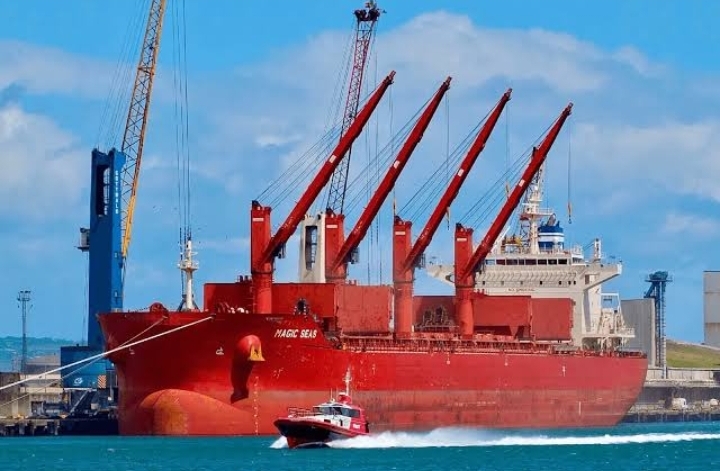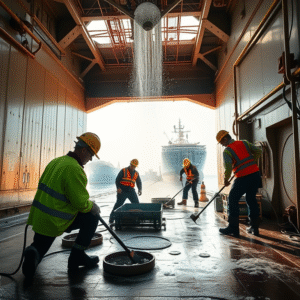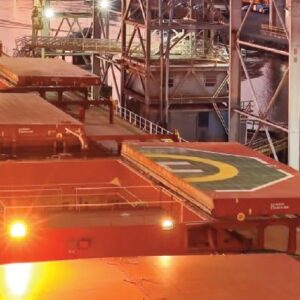Draught survey:
Before the start of loading the chief mate will normally undertake a draught survey. If an independent surveyor has been appointed the chief mate will accompany him on his survey, agree soundings and draught readings with him and then complete a separate set of calculations before comparing the final results with the surveyor. If no surveyor has been appointed the chief mate will simply take his own readings and complete his own calculations. Similar procedures will be followed on completion of loading.
Instructing junior officers:
It is the chief mate who normally prepares the ship’s loading/deballasting plan, and who is answerable to the Master for its implementation. The chief mate will have supervised the cleaning and preparation of the holds and will normally take personal charge of any of the more critical steps in the loading programme. The second and third mates, and engine room staff if necessary, will be provided by the chief mate with copies of the loading/deballasting plan and will be instructed by the chief mate as to his requirements. If there are any special matters to which he wants to draw particular attention, the chief mate will be well advised to put them in writing. When in writing they are available to the OOW for further reference and study as the loading progresses.
Commencement of loading:
The chief mate will normally be in attendance at the commencement of loading to ensure that a swift response can be made to any unexpected problems which occur. He will double-check that the loader can plumb the hold and that the cargo is the correct product being loaded in the intended position.
Monitoring of tonnages delivered:
Problems can be expected if the tonnages of cargo delivered by the shore installation are inaccurate. Unfortunately, shore personnel are not always certain of the accuracy of their measuring equipment or honest in informing the ship of the reliability of the tonnages loaded. When possible it is prudent to make an accurate check of the tonnages loaded at intervals during the loading, and this is something that the chief mate should try to do by undertaking informal draught surveys from time to time, without interrupting loading. Such surveys are useless unless the precise ballast condition is known, so they are best undertaken at the end of a stage in the deballasting when a full and upto-the-minute set of soundings of any working tanks can be obtained at the same time as a full set of draught readings at a time when loading is interrupted and the shiploader is moving from one position to another. This informal survey is less important than an actual draught survey, so it is acceptable to use earlier soundings for ballast tanks which have not been pumped in the meantime. With the information obtained from the informal draught surveys, the chief mate can calculate whether the shiploader is loading the planned tonnages or whether it appears to be loading too much or too little. If the errors are consistent a percentage error can be calculated, but it would be unwise to assume that the errors are consistent unless this is found in a succession of calculations. If the figure is consistent and significant (and errors of up to 10 per cent have been reported on occasion) it can be used to amend the quantities required for the tonnages in each pour.
Final stripping of ballast tanks:
The chief mate will normally take the opportunity at a time when the main deballasting is complete and the ship has a good stern trim, to satisfy himself that all the ballast tanks have been stripped to the fullest extent possible. This is an opportunity for him to use his experience to pump out a further tonnage of strippings, thereby enabling the ship to lift a corresponding additional tonnage of cargo. The final soundings to which the strippings in the ballast tanks are reduced should be carefully recorded for inspection by any independent draught surveyor. Soundings obtained when the ship has a substantial stern trim and properly corrected for that trim will provide a measurement of the contents remaining which may be more accurate than later soundings taken when the vessel is trimmed even keel prior to sailing.
Trimming pours:
The chief mate will calculate the quantities required for the trimming pours when he has obtained a full set of draught readings and has verified that all pumpable ballast has been discharged . To speed the process and to minimise the interruption in loading he may rely upon officers with VHF handsets to report some of the draught readings to him. The tonnages required for the trimming pours and the holds in which they are to be loaded will normally be passed to the loading foreman in writing, to avoid misunderstanding.
Topping off of holds:
When the ship is loading a low-density cargo such as coke or grain, where the holds have to be completely filled, the chief mate will try to view the completion of each hold to satisfy himself that it has been entirely filled and that no space has been lost. Where a cargo requires trimming to provide a level stow or to ensure the maximum tonnage loaded, the chief mate should satisfy himself that the work has been properly done. Where a hold is part-filled on completion of loading a low-density cargo he may wish to observe the ullage or to measure or estimate the space remaining. When the space remaining is known the space used can be calculated, permitting an accurate calculation of the final stowage factor for the cargo.
Special requirements for particular cargoes:
Many bulk cargoes require special attention. The lashing of steel cargoes and of timber deck cargoes, the separation of small parcels of bulk cargo, and the protection of chemical fertilisers from condensation require particular supervision, but no attempt has been made to deal with such matters here. The general point is that whenever the cargo requires special attention the chief mate will be actively involved, either by his presence in person or by the detailed instructions that he gives to his junior officers.
Damage claims:
It is essential that stevedores are warned immediately when they have caused or seem likely to cause damage to the ship or cargo. The chief mate should regularly emphasise the importance of this to his junior officers and should ensure that they issue the appropriate warnings, and/or report to him immediately, when damage occurs or is likely to occur. When damage occurs the chief mate will probably speak to the stevedores immediately to ensure that they are aware of the matter and should always follow this up immediately with a digital photo or photos and a written notice (which can be a standard stevedores’ damage form, or cargo damage form) when damage has occurred.
Securing for sea:
The chief mate will superintend the securing of the ship for sea, rechecking for himself where necessary the work of the crew as supervised by the officers of the watch. In some trades, hatch covers and accesses must be sealed by an official, who issues an appropriate certificate . (Some grain cargoes are fumigated on completion of loading.






